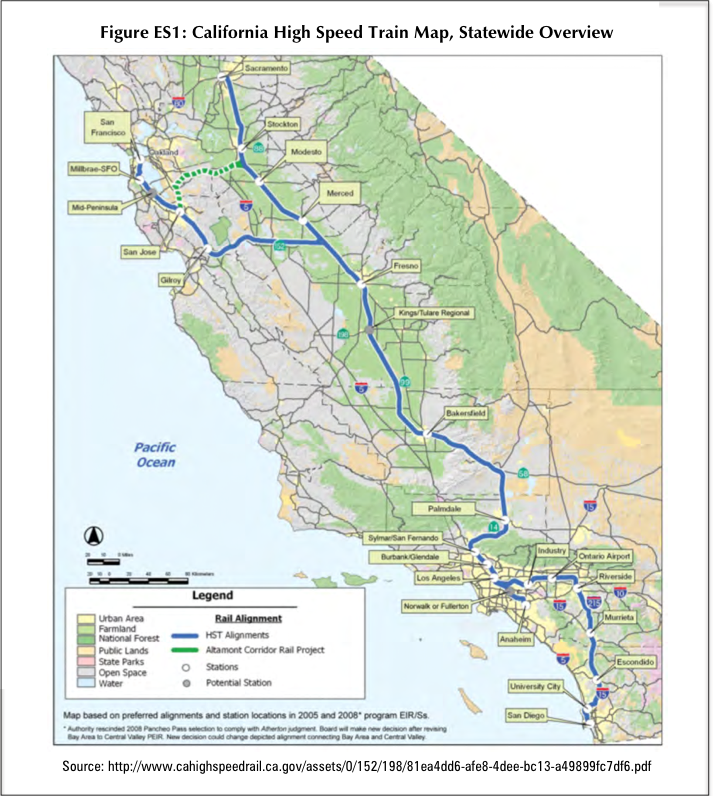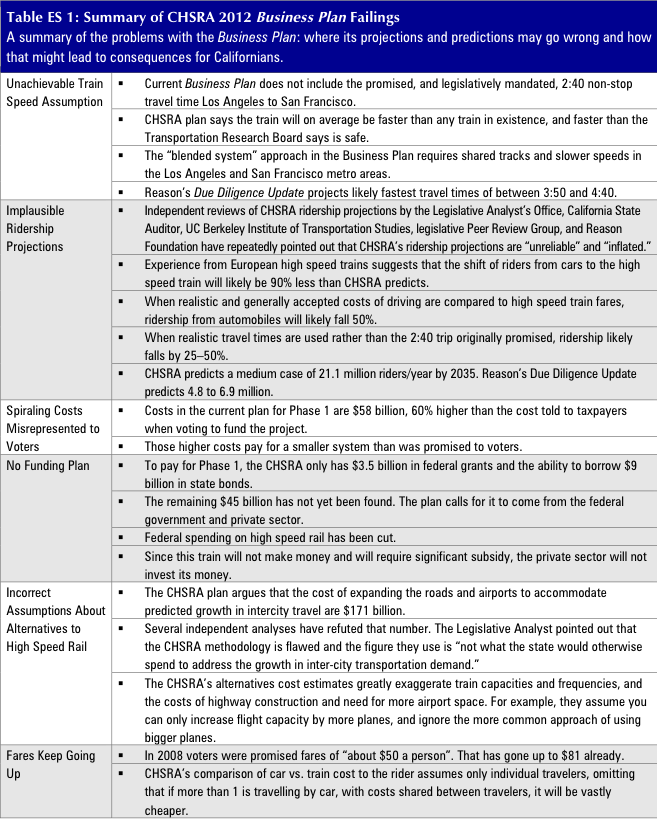REASON FOUNDATION
Executive Summary
Reason Foundation’s 2008 report, The California High Speed Rail Proposal: A Due Diligence Report, warned that plans by the California High-Speed Rail Authority (CHSRA or Authority) issued prior to and during 2008 were inaccurate, misleading and not in compliance with California statutes. As well, it found that the Authority’s financing plan overstated projected revenues and private financing, and understated capital requirements and operating subsidies needed from taxpayers. Subsequent independent studies and new Authority documentation have proven virtually every characterization in Reason’s 2008 Due Diligence Report to be accurate or understated.
This report updates Reason’s 2008 Due Diligence Report by addressing and evaluating numerous changes in California’s plan to build a high speed rail (HSR) system between San Francisco and Los Angeles via the San Joaquin Valley. This Due Diligence Update addresses the Authority’s revised documentation, business plans and public statements issued between 2008 and late-2012, which are found to be similarly inaccurate, misleading and in violation of the laws guiding the project. Additional analysis is warranted to respond to the Authority’s newer yet illusory capital cost reductions, likely capital cost escalations, need for operating subsidies, slower train schedules, high ridership projections, and the inability to meet the statutory requirement to link Los Angeles and San Francisco in 2 hours and 40 minutes or less.
The primary focus of this Due Diligence Update is the CHSRA’s Draft Revised Business Plan issued in April 2012 that outlines how high speed trains will operate on the same tracks as local commuter trains (“blended systems”) into San Francisco and Los Angeles, which now are called the “bookends” of the system. The blended system replaced the cost-prohibitive Full Phase 1 system that had new rail lines dedicated exclusively to high speed trains into San Francisco and Los Angeles. Despite the characteristics of the blended system that slow train-speed and shorten lines, which makes the system less high speed and less competitive, CHSRA continues to use the ridership and train-speed data from the Full Phase I system in its original plan in its analysis of the blended plan’s viability.
Current plans are now identified as “Phase 1 Blended,” which the CHSRA estimates will cost as much as $63.2 billion in 2011 inflation-adjusted dollars ($78.0 billion in year-of-expenditure dollars) with the only sources of funding being $9 billion in California Proposition 1A general obligation bonds and $3.5 billion in federal grants. Further funding is highly speculative if not outright non-existent for the remaining capital needed, which may exceed $50 billion.
As will be shown in this Due Diligence Update, the CHSRA April 2012 Business Plan is so deficient that it is inconceivable that policymakers would continue to rely on its assertions to evaluate the program. This report is not alone in identifying shortcomings in CHSRA’s plans and documentation, and will include findings from other state agencies and independent reviewers.
Read full report (PDF) here: California High Speed Rail
About Reason Foundation
reason.org
“Reason Foundation advances a free society by developing, applying, and promoting libertarian principles, including individual liberty, free markets, and the rule of law. Reason Foundation produces respected public policy research on a variety of issues and publishes the critically-acclaimed Reason magazine. Together, our top-tier think tank and political and cultural magazine reach a diverse, influential audience, advancing the values of choice, individual freedom and limited government.”
Tags: CA, California, California High-Speed Rail Authority, CHSRA, Reason Foundation








 RSS Feed
RSS Feed